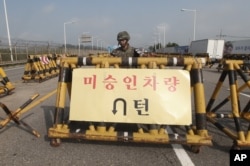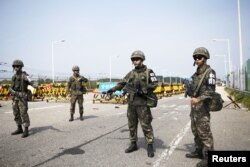South Korea turned off its propaganda broadcasts into North Korea on Tuesday as part of an agreement reached earlier in the day to defuse the latest tensions on the Korean peninsula.
South Korea’s national security adviser, Kim Kwan-jin, announced the joint agreement at the presidential “Blue House,” saying Pyongyang met Seoul’s key condition that it apologize for the recent provocations.
"North Korea has expressed regret over a landmine blast on the southern side of the DMZ that injured South Korean soldiers,” Kim said.
Seoul agreed to Pyongyang’s key demand to halt cross-border anti-Pyongyang loudspeaker broadcasts.
“Unless unusual incident occurs, South Korea has decided stop all loudspeaker broadcasting along the military demarcation line ... on August 25,” he said.
The diplomatic breakthrough occurred following three days of emergency talks that were hastily arranged Saturday after a Pyongyang-issued deadline expired for Seoul to halt cross-border audio broadcasts into the North or face military attacks.
The two sides have agreed to pull their militaries back from the brink of war after recent border incidents escalated tensions.
Landmine incident
The current crisis began August 4 when landmines planted by Pyongyang on the South’s side of the demilitarized zone detonated and injured two soldiers. Seoul responded by resuming anti-Pyongyang cross-border broadcasts for the first time in more than 10 years.
Last week, the two Koreas exchanged artillery fire in the DMZ near a loudspeaker tower; there were no casualties or damage reported from the attacks.
North Korean leader Kim Jong Un subsequently declared a “quasi-state of war,” and both sides quickly increased troop and armament deployment in preparation for a possible confrontation.
One impediment to reaching a deal was North Korea's denial of any involvement in the attacks.
Earlier, South Korean President Park Geun-hye publicly demanded that North Korea apologize and take measures to prevent a recurrence of these provocations before she would agree to end the loudspeaker broadcasts.
In the end, Pyongyang yielded to Seoul’s demand because it was anxious to halt the loudspeaker broadcasts that included criticism of Kim Jong Un.
North Korea tightly controls the media in-country and portrays the young leader as a near deity. However, in recent years there has been an increase of outside information entering the country through the porous border with China.
Family reunions
The two sides also agreed to hold reunions for families that were separated by the Korean War that divided the peninsula in the 1950s.
In her recent statement on the 70th anniversary of the end of World War Two, President Park had urged the North to join in arranging family reunions as both a humanitarian gesture and as a way to rebuild inter-Korean trust.
The two Koreas agreed to hold more talks in September about the reunions and to increase cultural, sports and other exchanges.
Washington and the United Nations welcomed the agreement.
U.S. State Department spokesman John Kirby said the U.S. is “hopeful it leads to decreasing tensions on the peninsula,” and that "it was a very tense several days."
Prior to the agreement, South Korea has been reporting unusual troop and submarine movement in the North. Pyongyang had moved submarines and warships away from their bases and doubled its frontline artillery strength at the border with the South.
US, South Korea ties
South Korea and the U.S. also strengthened their positions and were considering bringing in more U.S. military assets such as B-52 bombers that are stationed in the region.
The United States has more than 28,000 soldiers based in South Korea and is conducting annual joint military exercises with the South.
North Korea condemns these drills as rehearsals for invasion.
Seoul and Pyongyang technically remain in a state of war despite the truce that concluded the 1950-53 Korean War.
Youmi Kim in Seoul contributed to this report.















